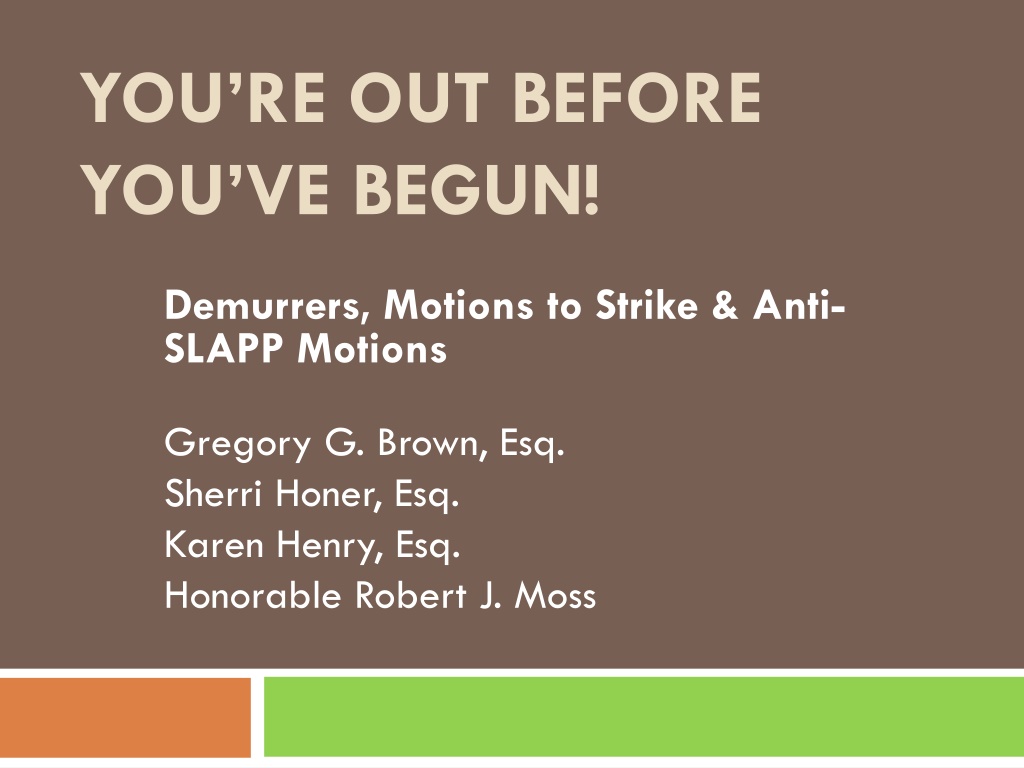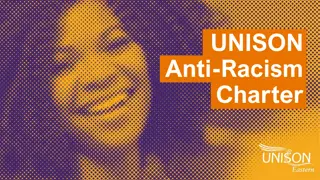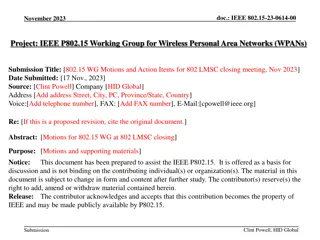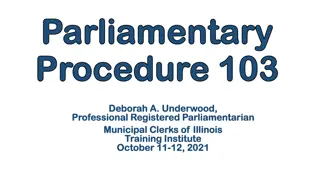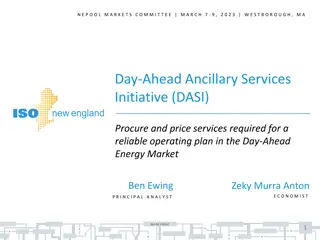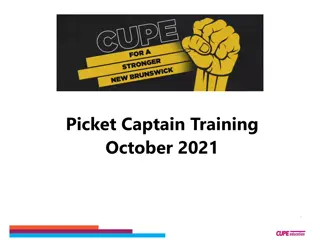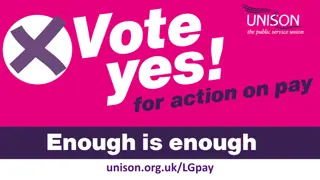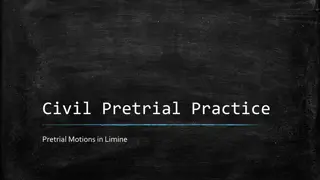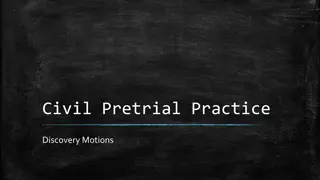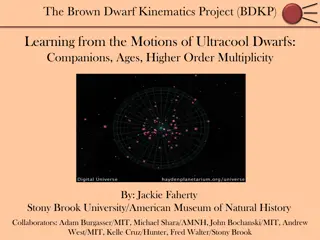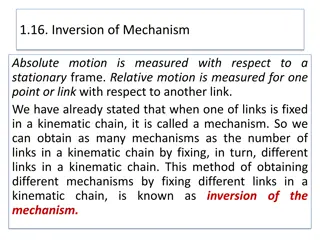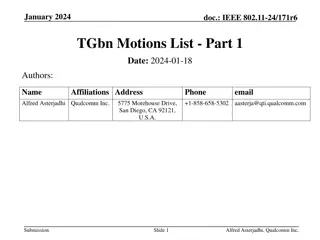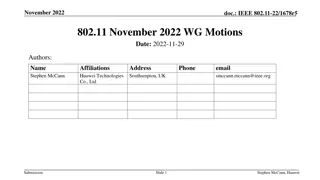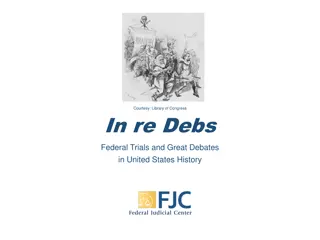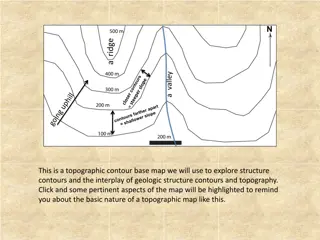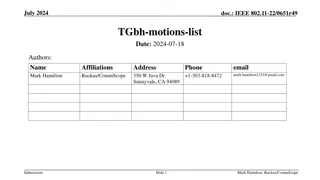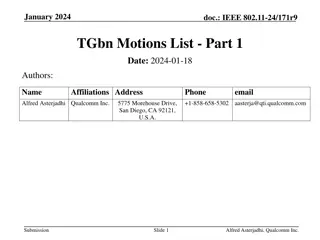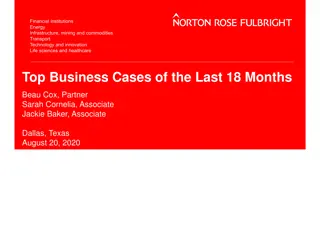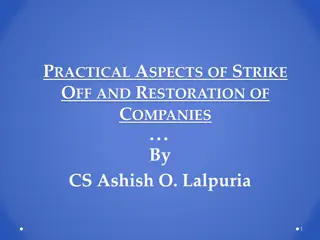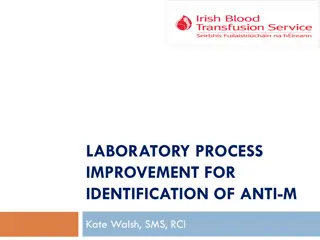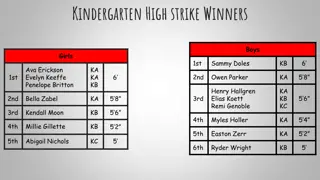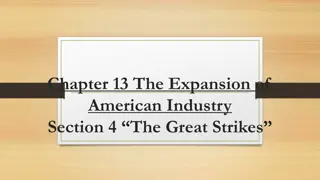Understanding Demurrers, Motions to Strike, and Anti-SLAPP Motions
Demurrers, motions to strike, and anti-SLAPP motions are legal procedures used to test the sufficiency of pleadings, challenge the face of a complaint, and address various grounds for objections in legal proceedings. This process involves reviewing the legitimacy of claims, the capacity of parties to sue, and addressing any defects or misjoinders in the case. Understanding the grounds for demurrers, when they can be brought, and the implications of non-meritorious demurrers is crucial in navigating legal disputes effectively.
Download Presentation

Please find below an Image/Link to download the presentation.
The content on the website is provided AS IS for your information and personal use only. It may not be sold, licensed, or shared on other websites without obtaining consent from the author. Download presentation by click this link. If you encounter any issues during the download, it is possible that the publisher has removed the file from their server.
E N D
Presentation Transcript
YOURE OUT BEFORE YOU VE BEGUN! Demurrers, Motions to Strike & Anti- SLAPP Motions Gregory G. Brown, Esq. Sherri Honer, Esq. Karen Henry, Esq. Honorable Robert J. Moss
Agenda Introduction 5 minutes 25 minutes 50 minutes 10 minutes Demurrers/Motions to Strike Anti SLAPP Motions/Atty Fees Questions
Demurrers CCP 430.10
What is a Demurrer? Demurrer is a method by which a party tests the sufficiency of the pleadings as a matter of law. ABF Capital Corp. v. Berglass, 130 CA 4th 825, 834 (2005) Demurrer is a challenge to the face of the pleading. Code Civ. Proc. 430.30(a) When any ground for objection to a complaint, cross-complaint, or answer appears on the face, or from any matter which court is required/may take judicial notice, the objection on that ground may be taken by a demurrer to pleading
Grounds for a Demurrer CCP 430.210 No jurisdiction over the subject of the cause of action The person who filed does not have the legal capacity to sue Other action pending between same parties on same claims There is a defect or misjoinder of parties Does not state facts sufficient to constitute a cause of action Pleading uncertain, which includes ambiguous & unintelligible Contract pleading does not state if written, oral, or implied Some professionals, no certificate of reasonable/merit filed Occupational negligence action brought by common interest development assoc. v. contractor & no certificate was filed Failure to attach certificate to complaint v. common interest development stating ADR attempted before lawsuit was filed
Grounds for a Demurrer Grounds for objection are waived unless raised by demurrer or answer, with the exception of "no jurisdiction of the subject of the cause of action" and "failure to state a cause of action Non-meritorious demurrers are subject to sanctions What about a Motion for Judgment on Pleadings?
WHEN CAN A DEMURRER BE BROUGHT? A party may demur 30 days after service of the complaint, or 10 days after service of the answer CCP 430.40 Alternatively, a court may increase the time to demur, or the parties may stipulate to an increase in time. CCP 473
General & Special Demurrers General Special General demurrer is a demurrer based on the ground the pleading does not state facts sufficient to constitute a cause of action A demurrer based on any of the other grounds set forth in CCP 430.10 is a special demurrer
Amendment of Pleading? After a hearing on a demurrer, a court must either sustain or overrule the demurrer: If the court sustains a demurrer, it may do so with or without leave to amend. If the court overrules a demurrer, and there is no answer filed, the court must allow an answer to be filed upon such terms as may be just. CCP 472a(c)
Motions to Strike CCP 435(b)(1)
What is a Motion to Strike? A motion to strike is generally used to challenge defects on the face of the pleading which are not susceptible to challenge by demurrer. Grieves v. Super. Ct., 157 Cal.App.3d 159 (1984) The motion may move to strike irrelevant, false, or improper matter in the pleading, or to strike out all or any part of the pleading which is not drawn in conformity with the laws of California, a court rule, or an order of the court. CCP 436
Grounds for a Motion to Strike Irrelevant, false, or improper matter Failed to draft in conformity with state law, court rule or order Failure to file a certificate of merit, where required Failure to deposit security for costs, where required As sanctions v. party for failure to comply with local rules As sanctions against a party for discovery abuses Complaint is frivolous on its face Failed to verify/properly verify a pleading when required Amendment filed without leave/new parties without permission Contains unexplained inconsistencies, mistakes, ambiguities, etc. Extraneous claims included in unlawful detainer proceeding An erroneous award of trial costs or defects in appellate brief
WHEN CAN A MOTION TO STRIKE BE BROUGHT? A party may move to strike 30 days after service of the complaint, or 10 days after service of the answer. CCP 435(b)(1) Alternatively, the time may be extended if made as part of a motion for judgment on pleadings. CCP 435(e) the
Pleadings Subject to Motion Complaint or cross-complaint - CCP 435 Answer - CCP 435 Demurrer - CCP 435 At-issue memorandum Cost memorandum - CRC 3.1700 Petition for mandamus or prohibition Appellate briefs - CRC 8.224
ATTORNEY'S FEES Where a court strikes a pleading for failure to comply with local rules, the order may include an award of the moving party's attorney's fees CCP 575.2(a)
Anti-SLAPP Motions CCP 425.16.
What is an Anti-SLAPP Motion? An anti-SLAPP (Strategic Lawsuits Against Public Participation) motion is a special motion to strike that enables a defendant to request the dismissal of a lawsuit that infringes on First Amendment rights. CCP 425.16
Legislative Policy In enacting the statute, the Legislature observed that there has been a disturbing increase in lawsuits brought primarily to chill the valid exercise of the constitutional rights of freedom of speech and petition for the redress of grievances. CCP 425.16(a)
Legislative Policy SLAPP plaintiffs do not intend to win their suits; rather, they are filed solely for delay and distraction, and to punish activists by imposing litigation costs on them for exercising their constitutional right to speak and petition the government for redress of grievances. Dixon v. Super. Ct., 30 Cal.App.4th 733 (4th Dist. 1994)
WHEN CAN AN ANTI-SLAPP MOTION BE BROUGHT? Anti-SLAPP motion may be filed within 60 days of service of complaint, or, in the court's discretion, at any time upon terms it deems proper CCP 425.16(f) The motion shall be scheduled by the clerk of the court for a hearing not more than 30 days after the service of the motion CCP 425.16(f)
Anti-SLAPP Procedure Anti-SLAPP motions involve a two-step inquiry: 1) Defendant must demonstrate the challenged cause of action is one arising from protected activity per CCP 425.16(e) 2) Court must then determine whether plaintiff has demonstrated a probability of prevailing on the claim - CCP 425.16(b)(1)
Anti-SLAPP Procedure There are separate burdens for each side Defendant has burden to show protected activity Burden then shifts to Plaintiff to show prima facie case Two pronged inquiry (below) Only when both prongs satisfied will a cause of action be stricken
Litigation Privilege Statements made during judicial proceedings generally protected CC 47 (b) There is an overlap between litigation privilege and Anti-SLAPP statute However, both protect a litigant s right of access to Courts without fear of harassment by subsequent tort actions
Two-Prong Inquiry Protected Activity Probability of Prevailing Statements/writings made before official proceeding Statements/writings re: issue under consideration/review by gov t body, or other official proceeding Statements/writings made in public and in connection with issue of public interest or Other conduct in furtherance of exercise of constitutional rights of petition or free speech re: issue of public interest Plaintiff must show claims have minimal merit However [in contrast to demurrer], court must consider facts so as to determine if plaintiff can establish prima facie probability of prevailing on claims. Thus, while court does not weigh evidence, it must determine whether plaintiffs have demonstrated . . . prevailing at trial. Blanchard v. DIRECTV, Inc., 123 Cal.App.4th 903, 921 (2d Dist. 2004)
Two-Prong Inquiry Protected Activity Probability of Prevailing Abstract public interest in the general subject matter may not support anti-SLAPP motion Rather, there must be a public interest in the specific speech or conduct alleged in complaint [T]he plaintiff must demonstrate that the complaint is both legally sufficient and supported by a sufficient prima facie showing of facts to sustain a favorable judgment if the evidence submitted by the plaintiff is credited. Wilson v. Parker, Covert & Chidester, 28 Cal. 4th 811, 821 (2002). World Fin. Group, Inc. v. HBW Ins. & Fin. Services, Inc., 172 Cal.App.4th 1561, 1570.
Evidence Required Protected Activity Probability of Prevailing To make initial determination, court must consider pleadings, as well as supporting and opposing affidavits stating the facts upon which the liability or defense is based. CCP 425.16(b)(2) Similarly, court considers the pleadings and evidentiary submissions of both plaintiff and defendant in making the determination of whether plaintiff has a likelihood of prevailing claims.
PROCEDURAL CONSIDERATIONS
Discovery Stay Once motion filed, all discovery stayed Court may order specified discovery be conducted on noticed motion and for good cause shown CCP 425.16(g) Plaintiff may need discovery file motion The hearing may need to be continued Time limits to protect plaintiff, not defendant
Effect of Anti-SLAPP Motion An anti-SLAPP motion can only eliminate causes of action in their entirety When cause of action contains both protected and unprotected activity, courts examine the principal thrust or gravamen of a plaintiff s cause of action to determine whether the anti-SLAPP statute applies. Ramona Unified Sch. Dist. v. Tsiknas, 135 Cal.App.4th510, 519- 20 (2005)
Amendment of Pleading? If special motion to strike is granted, court may not grant leave to amend to allege (or omit) facts demonstrating that the complaint is not subject to the statute Simmons v. Allstate Ins. Co., 92 Cal.App.4th1068, 1073 (2001) Court may, however, allow plaintiff to amend the complaint to show the probability of prevailing on the merits, based on evidence submitted in opposition to anti-SLAPP motion Nguyen-Lam v. Cao, 171 Cal.App.4th858, 870-71 (2009)
ATTORNEY'S FEES CCP 425.16(c)
Legislative Policy Fee-shifting provision of the anti-SLAPP statute was designed to place cost of litigation on those seeking to burden the exercise of constitutional rights of free speech and petition by bringing meritless claims. Ketchum v. Moses, 24 Cal. 4th1122, 1131 (2004). Trend has awakened, however, where SLAPP procedure has been used to chill the constitutional rights of plaintiffs to petition for redress of grievances. This abuse noted by Legislature to be contrary to the purpose and intent of [s]ection 425.16. CCP 425.17.
Prevailing Party Generally, if a defendant prevails on an anti-SLAPP motion to strike, he or she is entitled to recover attorney's fees and costs from the losing plaintiff CCP 425.16(c) If the anti-SLAPP motion is frivolous or is solely intended to cause unnecessary delay, however, the court is required to award fees and costs to the prevailing plaintiff Consumer Justice Ctr. v. Trimedica Int l, Inc., 107 Cal.App.4th 595 (2003)
No Practical Benefit When the results are minimal and insignificant, a court is fully justified in finding a party should not recover attorney s fees Endres v. Moran, 135 Cal.App.4th952, 955 (2006) Thus, if the relief granted is minimal to objectives of motion, court can deny an attorney s fee award If defendant knocks out an entire category of evidence, that would likely support fee award
Unsuccessful Claims If protected activity is only incidental to a cause of action based essentially on nonprotected activity, the protected activity fall within the anti-SLAPP arena Scott v. Metabolife Int l, 114 Cal.App.4th404, 415 (2004) If defendant is only partially successful, protections afforded a defendant must be balanced against the plaintiff s First Amendment rights Mann v. Quality Old Time Serv., 30 Cal.App.4th328, 344 (2006)
Unsuccessful Claims While award of fees is mandatory for prevailing defendant, a defendant is not entitled to attorney fees as a matter of right for both successful and unsuccessful claims. Ketchum v. Moses, 24 Cal. 4th1122, 1131 (2001) Anti-SLAPP statute authorizes an award of reasonable attorney fees to the prevailing party, irrespective of whether the prevailing party is the plaintiff or defendant. Robertson v. Rodriguez, 36 Cal.App.4th347, 362 (1995)
Frivolous Anti-SLAPP Motions If a court finds that an anti-SLAPP motion is frivolous or solely intended to cause unnecessary delay, that court is required to award reasonable attorney s fees and costs to a prevailing plaintiff. CCP 425.16(c) Ketchum v. Moses, 24 Cal. 4th1122, 1131(2001)
Inflated Fee Requests If trial court has concerns whether fee award is excessive, it has broad discretion to adjust the fee downward or deny an unreasonable fee altogether. Ketchum v. Moses, 24 Cal. 4th1122, 1138 (2001) Inflated fee requests are considered a special circumstance that allows a trial court to reduce or deny an award altogether Serrano v. Unruh, 32 Cal. 3d 621, 635 (1982)
